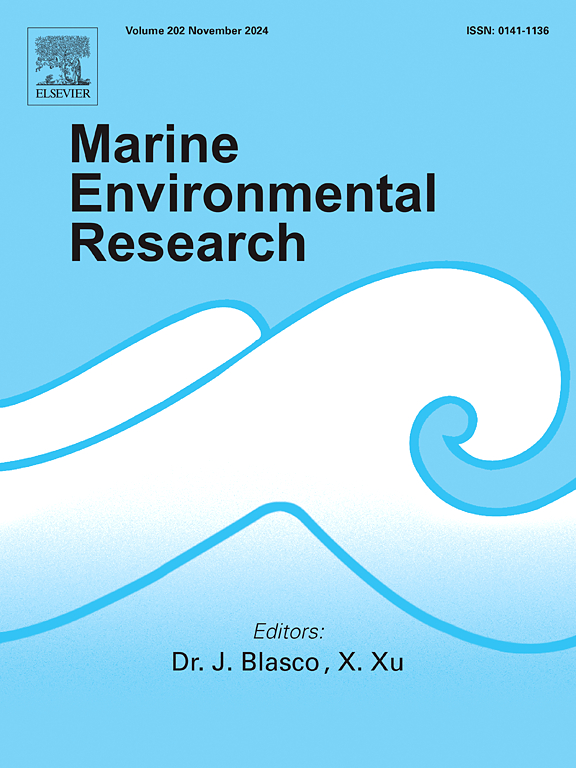The influence of artificial reef structural complexity on fish assemblage composition
IF 3
3区 环境科学与生态学
Q2 ENVIRONMENTAL SCIENCES
引用次数: 0
Abstract
Purpose
built artificial reefs (ARs) are becoming an increasingly popular tool for enhancing recreational fishing activities. This study examined the establishment of fish assemblages at a new AR site in the Exmouth Gulf, Western Australia (King Reef). A remotely operated vehicle fitted with stereo-video (stereo-ROV) was used to survey the fish assemblages associated with four different artificial reef modules (Fish Towers, Apollos, Abitats, and Pyramids). The observation of recreationally targeted species at the AR provides evidence of its potential to contribute to local recreational fisheries. There were differences in the fish assemblages associated with the different modules with the Fish Towers (large subsurface steel buoys) having the highest mean fish abundance and biomass. The design of the modules that are incorporated into an AR design have a considerable influence in shaping the assemblage and biomass of fishes at an AR site. Some differences between module types were not immediately obvious due to the close spacing of modules which created a relatively contiguous fish assemblage across the whole reef field. These results indicate that the characteristics of purpose-built structures that influence the associated fish assemblage can be manipulated to create a design that can fulfil a specific purpose, such as promoting the recruitment and attraction of targeted species to enhance recreational fishing opportunities.
人工鱼礁结构复杂性对鱼类组合组成的影响
专门建造的人工鱼礁正日益成为康乐垂钓活动的一项普及工具。本研究在西澳大利亚埃克斯茅斯湾(国王礁)的一个新的AR站点检查了鱼类群落的建立。装有立体视频(stereo-ROV)的远程操作车辆用于调查与四个不同人工礁模块(鱼塔,阿波罗,阿比塔和金字塔)相关的鱼类组合。在渔场观察到的以康乐为目标的鱼种,证明渔场有可能对本地康乐渔业作出贡献。不同模块相关的鱼类组合存在差异,其中鱼塔(大型地下钢浮标)的平均鱼类丰度和生物量最高。纳入AR设计的模块的设计对AR站点鱼类的组合和生物量的形成具有相当大的影响。模块类型之间的一些差异并不明显,因为模块之间的间隔很近,在整个礁场中形成了相对连续的鱼类组合。这些结果表明,可以操纵影响相关鱼类组合的特定建造结构的特征,以创建可以实现特定目的的设计,例如促进目标物种的招募和吸引,以增加休闲钓鱼的机会。
本文章由计算机程序翻译,如有差异,请以英文原文为准。
求助全文
约1分钟内获得全文
求助全文
来源期刊

Marine environmental research
环境科学-毒理学
CiteScore
5.90
自引率
3.00%
发文量
217
审稿时长
46 days
期刊介绍:
Marine Environmental Research publishes original research papers on chemical, physical, and biological interactions in the oceans and coastal waters. The journal serves as a forum for new information on biology, chemistry, and toxicology and syntheses that advance understanding of marine environmental processes.
Submission of multidisciplinary studies is encouraged. Studies that utilize experimental approaches to clarify the roles of anthropogenic and natural causes of changes in marine ecosystems are especially welcome, as are those studies that represent new developments of a theoretical or conceptual aspect of marine science. All papers published in this journal are reviewed by qualified peers prior to acceptance and publication. Examples of topics considered to be appropriate for the journal include, but are not limited to, the following:
– The extent, persistence, and consequences of change and the recovery from such change in natural marine systems
– The biochemical, physiological, and ecological consequences of contaminants to marine organisms and ecosystems
– The biogeochemistry of naturally occurring and anthropogenic substances
– Models that describe and predict the above processes
– Monitoring studies, to the extent that their results provide new information on functional processes
– Methodological papers describing improved quantitative techniques for the marine sciences.
 求助内容:
求助内容: 应助结果提醒方式:
应助结果提醒方式:


